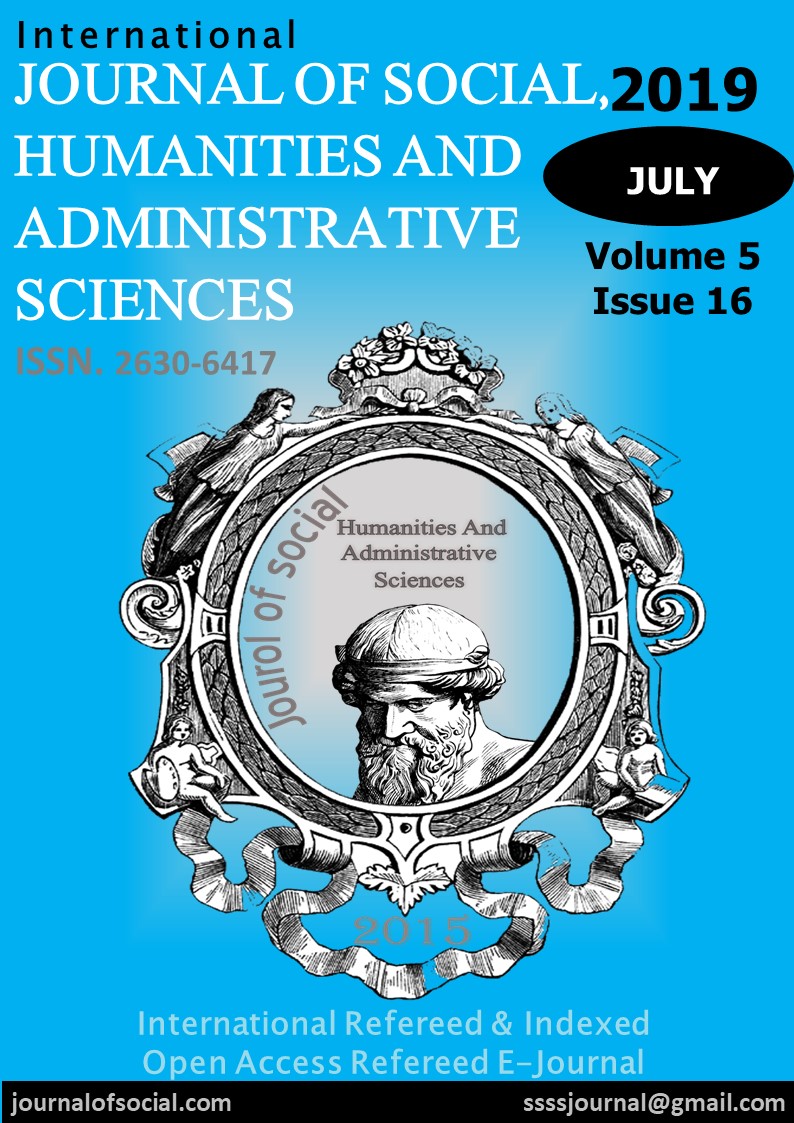REACTIONS OF ADOLESCENTS IN THE FORMAL OPERATIONAL STAGE TO THE SMART SIGNS DEPENDING ON THE TV WATCHING HABITS: AN EMPIRICAL RESEARCH ON ANKARA-TURKEY SAMPLE
Author :
Abstract
Akıllı işaretler ve onların bilgilendirici soyutlamaları, tüm dünyadaki TV programlarının içeriği ve olası olumsuz sonuçları ile ilgili uyarılar izleyiciler için kullanılmaktadır. 2006 yılında Türkiye'de de benzer bir uygulama yapılmıştır. Bu araştırmanın amacı, TV izleme alışkanlıklarına bağlı olarak formel işlemsel dönemdeki adölesanların tepkilerine bağlı olarak, akıllı işaretlerin Ankara-Türkiye'deki iletişim etkinliğini değerlendirmektir. Buna göre, Ankara'daki devlet okullarının 6., 7. ve 8. sınıflarına devam eden 384 öğrenciye, tabakalı örnekleme yöntemi kullanılarak anket uygulanmıştır. Sonuçlar, her gün altı saatten fazla TV izleyen ergenlerin daha aydınlık, çekici, ilginç ve kullanışlı bir işaret algıladıklarını, günlük TV izleyen gençlerin ise onları gereksiz kabul ettiğini göstermektedir.
Keywords
Abstract
Smart signs and their informative abstracts are utilized for warning audiences about the content and the possible negative consequences of TV programs all over the world. In the year of 2006, a similar application has been introduced in Turkey. The aim of this research is to evaluate the communication effectiveness of smart signs in Ankara-Turkey depending on the reactions of adolescents in the formal operational stage depending on the TV watching habits. According to that, a developed questionnaire was conducted to 384 students who are attending 6th, 7th and 8th grades of the public schools in Ankara by employed stratified sampling method. The results show that adolescents who watch TV daily more than six hours perceive the sign more luminous, attractive, interesting and useful whereas adolescents who watch TV daily lesser accept them unnecessary.
Keywords
- Allen E (2001). TV under the tree? Time 156(26): 164.
- Allen E (2001). TV under the tree? Time 156(26): 164.
- Arnett, JJ (1992). The soundtrack of recklessness: Musical preferences and reckless behavior among adolescents. Journal of Adolescent Research, 7, 313–331.
- Botta, R. A (2000). The mirror of television: A comparison of Black and White adolescents’ body image. Journal of Communication, 50, 144–162.
- Brown, J. D., Steele, J. R., & Walsh-Childers, K (Eds.). (2002). Sexual teens, sexual media: Investigating media’s influence on adolescent sexuality. New York, NY: Routledge.
- Collins R (2004). Watching sex on television predicts adolescent initiation of sexual behavior. Pediatrcs 144(39):280–289.
- Comstock, G, & Scharrer, E (1999). Television: What’s on, who’s watching and what it means. New York, NY: Academic Press.
- Dennis, E. E, & Pease, E. C (Eds.). (2000). Children and the media. New Brunswick, NJ: Transaction Publishers.
- Durham, G. M (2008). The Lolita effect: The media sexualization of young girls and what we can do about it. New York, NY: Overlook Press.
- Eagly, A., Chaiken, S (2007) The Advantages of an Inclusive Definition of Attitude, Social Cognition, 25, (5).
- Egan, J (2007) Marketing Communications,Thomson Learning, London.
- Gesell, A. and Ilg, F. L. and Ames, L. B (1956). Youth The Years From Ten To Sixteen, Harper and Brothers Pub., NewYork.
- Gray, W. M (1990). Formal operational thought. Reasoning, necessity, and logic: Developmental perspectives, 227-253.
- Haddock, G., Maio, G. R (2008) Attitudes: Content, Structure and Functions, Introduction to SocialPsychology: A European Perspective, Ed: Hewstone, M., Stroebe, W., and Jonas, K., 4th Edition, Blackwell Publishing, Oxford, UK,115-117.
- Huitt, W., & Hummel, J (2003). Piaget's theory of cognitive development. Educational Psychology Interactive. Valdosta, GA: Valdosta State University.
- Kirsh, S. J (2009). Media and youth: A developmental perspective. Hoboken, NJ: Wiley-Blackwell.Kohlberg, L (1975). The cognitive-developmental approach to moral education. Phi Delta Kappan, 670-677.
- Lamb, S., & Brown, L. M (2006). Packaging girlhood: Rescuing our daughters from marketers’ schemes. New York, NY: St. Martin’s Press.
- Lowry R, Wechsler H, Galuska A et al. (2002). Television viewing and its associations withoverweight, sedentary lifestyle, and insufficient consumption of fruits and vegetables among us high school students: differences by race, ethnicity, and gender. Journal of School Health
- Öktem, F., Sayıl, M. ve Özen, Ç (2006). “Akıllı İşaretler Kodlama Kitapçığı”, Ankara.
- Stewart, D. W., & Martin, I. M (1994). Intended and unintended consequences of warning messages:A review and synthesis of empirical research. Journal of Public Policy & Marketing, 13(1), 1-19.
- Türkkent, E (2012). Okul öncesi dönem çocuklarının televizyondan etkilenmeleri konusunda anne veöğretmen görüşleri. T.C. Mehmet Akif Ersoy Üniversitesi Eğitim Bilimleri Enstitüsü İlköğretim Anabilim dalı, Okul öncesi eğitimi programı, yayınlanmamış yüksek lisans tezi, Burdur.
- Vessey J, Yim-Chiplis P, MacKenzie N (1998). Effects of television viewing on children’s development. Pediatric Nursing 24(5): 483–486.
- Villani, S (2001). Impact of media on children and adolescents: A 10-year review of the research. The American Academy of Child and Adolescent Psychiatry, 40(4), 392–401.
- Wikipedia (2013). Television Rating Content Systems. Çevrimiçi: http://en.wikipedia.org/wiki/Television_content_rating_systems, Erişim: 05.08.2013.
- Zimmerman F, Christakis D, DiGiuseppe D et al. (2004). Early television exposure and subsuquent attentional problems in childiren. Pediatrics 113(4):708–713.





